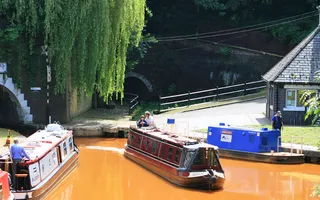Although described as a single tunnel, Harecastle is actually made up of two separate parallel canals and smaller canals leading into the mines.
History of Harecastle Tunnel
On the Trent & Mersey Canal, the Harecastle Tunnel was once the longest in the country.

Taking 11 years to build, the tunnel is only 12 feet at its highest point and nine feet at its widest. To build the tunnel, James Brindley sank 15 vertical shafts into Harecastle Hill, from which navvies mined outwards.
Measuring 2,630 metres long, Brindley’s tunnel became the longest in the UK upon completion. However, the lack of towpath and tight constraints meant boatmen had to ‘leg’ their way through. This involved laying on their backs on the roof of the boat and using their legs to propel the boat through the tunnel. It was slow, tough work, and it took three hours, on average, to navigate.
The main tunnel had a network of smaller canals leading into the mines at Goldenhill, in which Brindley had a share. This branch was closed in 1820 when it became unsafe.
Similar canal tunnel networks exist at Dudley and Worsley Delph. Small boats – like this ‘Starvationer’ at Ellesmere Port – took miners into the adjacent coal workings to load coal straight onto the boat, without needing to haul it to the surface.

Not long after completion, the limitations of the tunnel became quickly evident. Thomas Telford, renowned engineer, began work on a second canal line through Harecastle Hill.
Telford’s tunnel

By the 1820s, the slow process of legging through Brindley’s tunnel created a major bottleneck. With advancements in engineering, the second tunnel only took three years to complete. This tunnel was larger with space for a towpath, meaning boaters no longer had to leg their way through.
The two tunnels worked together, each taking traffic in a different direction.
Today, you can only access Telford’s tunnel. The original tunnel was closed in 1914 due to subsidence, and the network of mining canals remain unexplored since the 1960s.
Last Edited: 15 November 2024


Stay connected
Sign up to our newsletter and discover how we protect canals and help nature thrive


